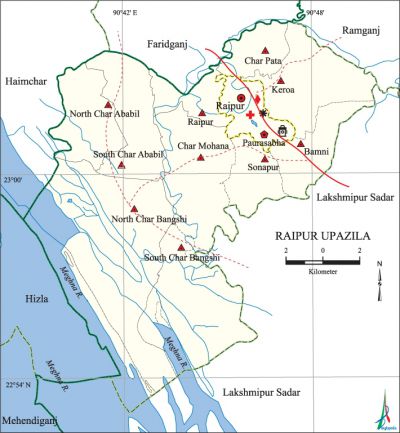Raipur Upazila
Raipur Upazila (lakshmipur district) area 195.98 sq km, located in between 22°53' and 23°04' north latitudes and in between 90°38' and 90°50' east longitudes. It is bounded by faridganj and ramganj upazilas on the north, lakshmipur sadar and mehendiganj upazilas on the south, Lakshmipur Sadar upazila on the east, hizla and haimchar upazilas and meghna river on the west.
Population Total 275160; male 132284, female 142876; Muslim 266222, Hindu 8903, Buddhist 5, Christian 7 and others 23.
Water bodies Main river: Meghna.
Administration Raipur Thana was formed in 1877 and it was turned into an upazila on 24 March 1983.
| Upazila | ||||||||
| Municipality | Union | Mouza | Village | Population | Density (per sq km) | Literacy rate (%) | ||
| Urban | Rural | Urban | Rural | |||||
| 1 | 10 | 48 | 83 | 59352 | 215808 | 1404 | 55.9 (2001) | 47.9 |
| Municipality | ||||||||
|
Area (sq km) |
Ward |
Mahalla |
Population |
Density (per sq km) |
Literacy rate (%) | |||
| 10.02 (2001) | 9 | 15 | 30756 | 2569 (2001) | 60.8 | |||
| Upazila Town | ||||||||
|
Area (sq km) |
Mouza |
Population |
Density (per sq km) |
Literacy rate (%) | ||||
| 22.06 (2001) | 4 | 28596 | 1252 (2001) | 64.7 | ||||
| Union | ||||
| Name of union and GO code | Area (acre) | Population | Literacy rate (%) | |
| Male | Female | |||
| North Char Ababil 23 | 3384 | 12896 | 13693 | 47.2 |
| North Char Bangshi 35 | 12079 | 17599 | 19111 | 47.5 |
| Keroa 59 | 4140 | 14035 | 16633 | 65.5 |
| Char Mohana 47 | 5985 | 12783 | 12616 | 49.5 |
| Char Pata 52 | 1936 | 6814 | 8052 | 58.0 |
| South Char Ababil 28 | 4029 | 11039 | 12300 | 47.5 |
| South Char Bangshi 38 | 6987 | 13630 | 13421 | 32.4 |
| Bamni 11 | 3610 (2001) | 11394 | 13634 | 63.6 |
| Raipur 71 | 1649 | 5771 | 5933 | 48.8 |
| Sonapur 83 | 2309 | 11258 | 11792 | 57.4 |
Source Bangladesh Population Census 2001 and 2011, Bangladesh Bureau of Statistics.

Archaeological heritage and relics Three domed Jinn's Mosque (18th century) at village Keroa, Zamindar Bari at Shayestanagar.
War of Liberation The Pak army established a Razakar Camp in the Raipur Aliya Madrasa during the war of liberation. The razakars killed many people including freedom fighters in this camp. Freedom fighters had encounters with the Pak army at Kafilatali and at Kazir Dighir Par. Notable among the encounters of freedom fighters with the Pak army in the upazila was the attack on the Pak army camp of the Raipur L. M High School. A memorial monument was built in front of the Upazila Parisad Auditorium.
For details: see রায়গঞ্জ উপজেলা, বাংলাদেশ মুক্তিযুদ্ধ জ্ঞানকোষ (Encyclopedia of Bangladesh War of Liberation), বাংলাদেশ এশিয়াটিক সোসাইটি, ঢাকা ২০২০, খণ্ড ৯।
Religious institutions Mosque 308, temple 9, tomb 5, dargah 1. Noted religious institutions: Raipur Bara Mosque, Jinn's Mosque, Pirbari Mosque, Dargah of Bara Mian Saheb.
Literacy rate and educational institutions Average literacy 51.1%; male 50.9%, female 51.3%. Educational institutions: college 3, secondary school 26, primary school 80, madrasa 21. Noted educational institutions: Raipur Womens' College (1963), Raipur Government College (1970), Char Ababil SC High School (1910), Raipur LM Pilot High School (1911), Char Ababil Rachim Uddin High School (1914), North Keroa Government Primary School (1895), Raipur Aliya Madrasa (1886), Lamchari Karamatia Fazil Madrasa (1922).
Newspapers and periodicals Fortnightly: Abasar, monthly: Dakatia, quaterly: Raipur Darpan (1998), Prothom Jagaran.
Cultural organisations Library 1, club 1, press club 1, society and organisation 78, women organisation 53, music school 1, theatre group 1, cinema hall 2. Noted Cultural organisation: Khelaghar.
Main sources of income Agriculture 47.16%, non-agricultural labourer 2.85%, industry 0.70%, commerce 14.01%, transport and communication 4.14%, service 9.69%, construction 2.28%, religious service 0.47%, rent and remittance 8.71% and others 9.99%.
Ownership of agricultural land Landowner 51.92%, landless 48.08%; agricultural landowner: urban 51.45% and rural 52.06%.
Main crops Paddy, jute, wheat, sugarcane, mustard, potato, soybean, maize.
Extinct or nearly extinct crops Kaun, joar, sesame, linseed, khesari, kalai.
Main fruits Coconut, betel nut, mango, jackfruit, banana, hog-plum, lemon.
Fisheries, dairies and poultries Fishery 8, poultry 72, hatchery 9, dairy farm 14.
Communication facilities Pucca road 213 km, semi-pucca road 37 km, mud road 433 km; waterway 24 km. Embankment 96.5 km.
Extinct or nearly extinct traditional transport Palanquin, bullock cart.'
Noted manufactories Textile mill 1, rice mill 62, flour mill 25, biscuit factory 14, ice factory 7, bidi factory 2, saw mill 30, oil mill 5, welding factory 25, aluminium factory 1, brick-field 4.
Cottage industries Goldsmith, bamboo and cane work.
Hats, bazars and fairs Hats and bazars are 28, most noted of which are Raipur Bazar, Haiderganj Bazar, Khaser Hat, Rakhalia Hat.
Main exports Coconut, betel nut, soybean, maize.
Access to electricity All the wards and unions of the upazila are under rural electrification net-work. However 44.7% of the dwelling households have access to electricity.
Sources of drinking water Tube-well 90.5%, tap 4.6% and others 4.9%.
Sanitation 78.7% of dwelling households of the upazila use sanitary latrines and 19.2% of dwelling households use non-sanitary latrines; 2.1% of households do not have latrine facilities.
Health centres Upazila health complex 1, satellite clinic 2, family planning centre 7, clinic 6.
NGO activities Operationally important NGOs are brac, proshika, asa. [Nazmul Ahsan Raju]
References Bangladesh Population Census 2001 and 2011, Bangladesh Bureau of Statistics; Cultural survey report of Raipur Upazila 2007.
